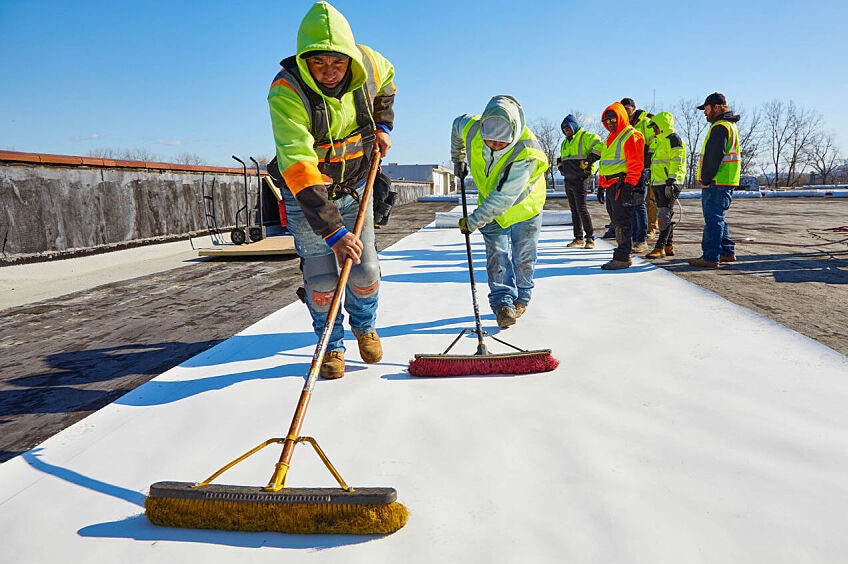The approach of cooler weather doesn't have to mean the end of roofing season. Cool weather application of single-ply roofing systems, including EverGuard® TPO and PVC, is possible if contractors follow proper procedures and the manufacturer's recommendations for cooler weather installation.
What Is Cool Weather Application?
In the roofing industry, ambient temperatures lower than 40°F (4,4°C) are considered cool weather installation, but there's more to it than just the ambient temperature at the jobsite. It's important to consider other factors that can have an impact, as well, including wind chill, surface temperature, humidity level, precipitation, and the amount of sun exposure that will be present.
After taking all these factors into consideration, the next step for success is to plan carefully. By planning and following the manufacturer's recommendations, contractors can help minimize the potential for cool weather pitfalls, such as membrane wrinkling, adhesion failures, poor welds, and blisters.
How to Plan for Cool Weather Application
First, create a plan that will allow your crew to fully complete each section of the roof, ensuring there is no precipitation in the forecast during those times. It's important to avoid partially finished areas that could be exposed to cold or precipitation overnight.
Material storage is an important consideration, too, because water-based products should be kept warm to avoid freezing, and solvent-based products must be at a specific temperature before they can be installed to perform optimally. Solvent-based adhesives also need to be kept above a certain temperature when applying, which may necessitate heat blankets. Membranes should remain in temperature-controlled storage until ready to be installed. Cooler temperatures can cause thermoplastics to become stiffer and harder to roll out and work with.
Don't forget about your crew in the cold weather. Workers in cold temperatures are at risk of cold stress, putting their safety at risk. Educate them on the proper gear for cold weather work and consider providing portable outdoor heaters and a warming tent for breaks.
Best Practices for Cool Weather Application
GAF has best practice recommendations for cool weather application that can help contractors achieve a quality installation in temperatures below 40°F. Here are some key components to keep in mind:
- Membrane storage. By leaving membrane rolls in storage until ready to install, they will remain more flexible and easier to work with.
- Seam welding settings. Outdoor conditions play a big role in your welder settings. Lower air temperatures will typically require slower speed settings, allowing the welder to deliver the additional heat energy needed to compensate for the cooler conditions. Hand welders will require consideration and adjustment for cooler temperatures.
- Field test welds. Field test welds are critical to finding the correct settings for your welders. Conditions and temperatures can change throughout the day, so test welds will need to be done several times per day. Always test in the morning before work begins, after any extended breaks, and after any changes in the weather, such as a change in wind speed or temperature. Daily quality control checks should be done, including probing and checking seams at the end of the workday.
- Adhesives, sealants, and primers. Lower temperatures mean these products will take longer to flash off and dry. Also, be aware of the "working time" for solvent-based spray adhesives. The working time is the time between flash off and when the adhesive no longer has any tack. In cooler weather, the working time of solvent-based spray adhesives can diminish significantly. As such, always store these products in warmer temperatures and leave them stored until ready to use. Make sure to bring them up to and maintain the manufacturer's recommended temperature using heat boxes or heat blankets before use and during use, if necessary.
- Fasteners. When installing EverGuard® TPO and PVC in temperatures below 40°F using fasteners, wrinkles may form due to the expansion and contraction caused by temperature fluctuations. GAF advises that wrinkles less than one inch high when pressed together typically won't affect the integrity of the system. It's recommended to perform test welds throughout the day to ensure the settings on your RhinoBond® induction tool are correct.
Support for Cool Weather Application Success
If you're wondering if a project is a candidate for a cool weather installation or need guidance in navigating the best system options for the building, GAF won't leave you out in the cold.
GAF Design Services Can Assist You with these and other questions you may have. GAF Design Services can be contacted at 877-423-7663 or DesignServices@gaf.com. The GAF website is a great resource for just about any question you may have or for additional information you may require. Please visit www.gaf.com to find the latest information on our products and their installation.

